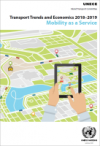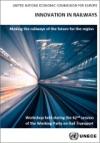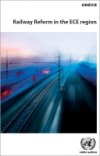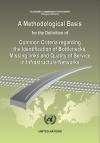Publications
Displaying Results 21 - 40 of 47
- English
Mobility as a Service (MaaS) is a new mobility concept gaining pace in many cities around the world. Its value proposition concerns integration of mobility services which is realized by providing trip planning and one-stop fare purchase for the user through a single platform.Since MaaS is only emerging, the analysis of real-life demonstrations is still limited and, thus, evidence on the
- English
Regional maps available here
Extreme weather events, some of which are increasing in intensity and frequency, as well as slower onset climate changes (for example, sea level rise) and cumulative effects can result in transportation infrastructure damages, operational disruptions, and
- English
As part of the ongoing activities of the Working Party on Rail Transport (SC.2) a workshop titled “Making rail freight more competitive: The coordinated development of the rail network with a focus on how to work together at the government and sectoral levels on the EATL” was held at the seventy-third session of the Working Party.Over 60 participants from national administrations,
- English
As part of the ongoing activities of the Working Party on Rail Transport (SC.2) a workshop titled “Making the railways of the future for the region” was held at the seventy-second session of the Working Party.Over 65 participants from national administrations, international organizations, non-governmental organizations and the private sector discussed, over a number of sessions, the role of
- English
During recent decades governments all around the world were faced with a complicated set of options for investing in transport, including transport infrastructure. This publication examines main principles for determining the most appropriate models for financing transport infrastructure expenditures but also illustrates and analyses many innovative ways to finance transport infrastructure.
- Pусский
This study on railway reform in the ECE Region looks at the history of railway reform within its member States and looks at how it has been implemented through a number of examples, highlighting that railway reform across the ECE region has taken different forms in terms of institutional structure, market participants and development of the sector.
- Français
This study on railway reform in the ECE Region looks at the history of railway reform within its member States and looks at how it has been implemented through a number of examples, highlighting that railway reform across the ECE region has taken different forms in terms of institutional structure, market participants and development of the sector.
- English
This study on railway reform in the ECE Region looks at the history of railway reform within its member States and looks at how it has been implemented through a number of examples, highlighting that railway reform across the ECE region has taken different forms in terms of institutional structure, market participants and development of the sector.
- English
eTIR: Towards Paperless Cross-border TradeThis study is a joint effort by UNECE, ESCAP and IRU to present
- English
The inclusion of urban transport in the SDG 11 is further confirmation that transport is an essential component of the overall sustainable development. It is crucial to eradicating poverty and economic growth (access to markets and jobs), improving education (access to schools), protecting child and maternal health (access to medical services), and enhancing
- English
TIR and eTIR in the ESCAP regionUNECE, in collaboration with ESCAP, prepared a Policy Brief for the
- English
- English
Transport Trends and Economics 2011-2012Download PDF (English)
- English
EnglishFollowing discussions about the need to update the methodology for the identification of bottlenecks and missing links adopted by the Inland Transport Committee in the early 1990s, government delegates in the UNECE Working Party on Transport Trends and Economics agreed to commission a new report on this topic. An informal group of
- English
- English



















